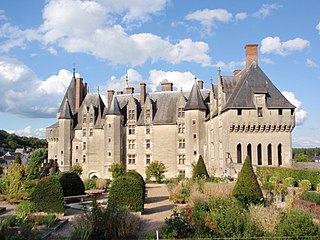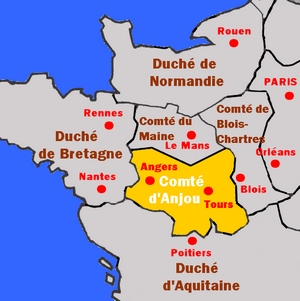Related Research Articles

The Battle of Bouvines was fought on 27 July 1214 near the town of Bouvines in the County of Flanders. It was the concluding battle of the Anglo-French War of 1213–1214. Although estimates on the number of troops vary considerably among modern historians, at Bouvines, a French army commanded by King Philip Augustus routed a larger Allied army led by Holy Roman Emperor Otto IV in one of the rare pitched battles of the High Middle Ages and one of the most decisive medieval engagements.

Year 992 (CMXCII) was a leap year starting on Friday of the Julian calendar.

The Château d'Amboise is a château in Amboise, located in the Indre-et-Loire département of the Loire Valley in France. Confiscated by the monarchy in the 15th century, it became a favoured royal residence and was extensively rebuilt. King Charles VIII died at the château in 1498 after hitting his head on a door lintel. The château fell into decline from the second half of the 16th century and the majority of the interior buildings were later demolished, but some survived and have been restored, along with the outer defensive circuit of towers and walls. It has been recognised as a monument historique by the French Ministry of Culture since 1840.

The Château de Langeais is a 15th-century Flamboyant Gothic castle in Indre-et-Loire, France, built on a promontory created by the small valley of the Roumer River at the opening to the Loire Valley. Founded in 992 by Fulk Nerra, Count of Anjou, the castle was soon attacked by Odo I, Count of Blois. After the unsuccessful attack, the now-ruined stone keep was built; it is one of the earliest datable stone examples of a keep. Between 994 and 996, the castle was besieged unsuccessfully twice more. During the conflict between the counts of Anjou and Blois, the castle changed hands several times, and in 1038 Fulk captured the castle again.

The Duchy of Brittany was a medieval feudal state that existed between approximately 939 and 1547. Its territory covered the northwestern peninsula of Europe, bordered by the Atlantic Ocean to the west, and the English Channel to the north. It was also less definitively bordered by the river Loire to the south, and Normandy, and other French provinces, to the east. The Duchy was established after the expulsion of Viking armies from the region around 939. The Duchy, in the 10th and 11th centuries, was politically unstable, with the dukes holding only limited power outside their own personal lands. The Duchy had mixed relationships with the neighbouring Duchy of Normandy, sometimes allying itself with Normandy, and at other times, such as the Breton-Norman War, entering into open conflict.

The Battle of Auray took place on 29 September 1364 at the Breton-French town of Auray. This battle was the decisive confrontation of the Breton War of Succession, a part of the Hundred Years' War.
Geoffrey I, also known as Geoffrey of Rennes and Geoffrey Berengar, was the eldest son of Duke Conan I of Brittany. He was Count of Rennes, by right of succession. In 992 he assumed the title of Duke of Brittany, which had long been an independent state, but he had little control over much of Lower Brittany.

Alan IV was Duke of Brittany from 1072 until his abdication in 1112. He was also Count of Nantes and Count of Rennes. His parents were Duchess Hawise and Duke Hoel II. He is also known as Alan Fergant. Through his father, he was of the Breton House of Cornouaille dynasty. He was the last Breton-speaking Duke of Brittany.

Fulk III, the Black (c. 970–1040; Old French: Foulque Nerra was an early Count of Anjou celebrated as one of the first great builders of medieval castles. It is estimated Fulk constructed approximately 100 castles as well as abbeys throughout the Loire Valley in what is now France. He fought successive wars with neighbors in Brittany, Blois, Poitou and Aquitaine and made four pilgrimages to Jerusalem during the course of his life. He had two wives and three children.

Geoffrey I of Anjou, known as Grisegonelle, was count of Anjou from 960 to 987.

The term Angevin Empire describes the possessions of the House of Plantagenet during the 12th and 13th centuries, when they ruled over an area covering roughly half of France, all of England, and parts of Ireland and Wales, and had further influence over much of the remaining British Isles. It may be described as an early example of a composite monarchy. The empire was established by Henry II of England, who succeeded his father Geoffrey as Duke of Normandy and Count of Anjou. Henry married Eleanor of Aquitaine in 1152, acquiring the Duchy of Aquitaine, and inherited his mother Empress Matilda's claim to the English throne, succeeding his rival Stephen in 1154. Although their title of highest rank came from the Kingdom of England, the Plantagenets held court primarily on the continent at Angers in Anjou, and at Chinon in Touraine.
Conan I, nicknamed Le Tort, was the Duke of Brittany from 990 to his death.
The siege of St. James took place between 27 February and 6 March 1426 between England and France, during the latter half of the Hundred Years' War.

The Battle of Morlaix was fought in Morlaix on 30 September 1342 between the Anglo-Breton and Franco-Breton forces in Brittany. The Anglo-Breton under English command besieged the town, but a Franco-Breton relief force arrived. The English constructed a strong defensive position. After repeated attacks, the French forced the English to retreat into the woods, and the French force then withdrew.
Theobald I, called the Trickster, was Count of Blois, Tours, Chartres and Châteaudun, as well as Lord of Vierzon and Provins. He was a loyal and potent vassal of Hugh the Great, duke of the Franks.
Herbert I, called Wakedog, was the count of Maine from 1017 until his death. He had a turbulent career with an early victory that may have contributed to his later decline.
The Battle of Champtoceaux, often called the Battle of l'Humeau, was the opening action of the 23-year-long War of the Breton Succession, a dynastic conflict in the Sovereign Duchy of Brittany which became inevitably embroiled in the Hundred Years War between England and France. This battle should have decided the war at a stroke, as John of Montfort, the leader of one faction, was made prisoner. However his wife, Joanna of Flanders, and young son John escaped imprisonment. Their escape and continued support from his ally, England, allowed continued resistance to flourish and eventually turn the tide.
Ermengarde of Anjou,, was the Countess of Rennes, Regent of Brittany (992–994) and also Countess of Angoulême.
Bernard Stanley Bachrach was an American historian. He taught history at the University of Minnesota from 1967 until his retirement in 2020. He specialized in the Early Middle Ages, mainly on the topics of medieval warfare, medieval Jewry, and early Angevin history.
Hoël I of Brittany was an illegitimate son of Alan II and Judith. He was Count of Nantes and Duke of Brittany from 960 to 981.
References
- ↑ Bachrach 1993, p. 101.
- 1 2 Bachrach 2006, p. 157.